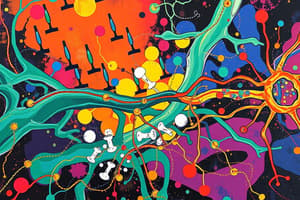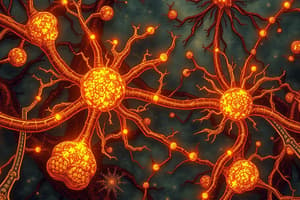Podcast
Questions and Answers
During retrograde transport, which motor protein is responsible for moving cargo towards the negative end of microtubules?
During retrograde transport, which motor protein is responsible for moving cargo towards the negative end of microtubules?
- Kinesin
- Myosin
- Dynein (correct)
- Actin
What type of bond is formed between amino acids during a condensation reaction?
What type of bond is formed between amino acids during a condensation reaction?
- Disulfide bond
- Hydrogen bond
- Peptide bond (correct)
- Ionic bond
Which of the following is NOT a step in the process of protein synthesis?
Which of the following is NOT a step in the process of protein synthesis?
- Transcription
- Replication (correct)
- Translation
- Post-translational modification
Which level of protein structure involves the formation of α-helices and β-pleated sheets due to hydrogen bonding?
Which level of protein structure involves the formation of α-helices and β-pleated sheets due to hydrogen bonding?
Which of the following is a characteristic of amino acids?
Which of the following is a characteristic of amino acids?
What is the difference between β-amyloid plaques and neurofibrillary tangles?
What is the difference between β-amyloid plaques and neurofibrillary tangles?
What is the primary function of the hydrophobic tails of phospholipids in the plasma membrane?
What is the primary function of the hydrophobic tails of phospholipids in the plasma membrane?
Which of the following is NOT a characteristic of the plasma membrane?
Which of the following is NOT a characteristic of the plasma membrane?
Which of these components is NOT part of the SNARE complex?
Which of these components is NOT part of the SNARE complex?
What is the primary function of a ligand in the context of neuronal signaling?
What is the primary function of a ligand in the context of neuronal signaling?
Which of the following BEST describes the role of a neurotransmitter in the neuromuscular junction?
Which of the following BEST describes the role of a neurotransmitter in the neuromuscular junction?
What is the primary function of Acetylcholinesterase in the synaptic cleft?
What is the primary function of Acetylcholinesterase in the synaptic cleft?
Which of the following BEST describes the difference between endogenous and exogenous substances in the context of brain function?
Which of the following BEST describes the difference between endogenous and exogenous substances in the context of brain function?
How do antagonists influence the activity of a receptor?
How do antagonists influence the activity of a receptor?
What is the role of synaptic vesicles in neurotransmission?
What is the role of synaptic vesicles in neurotransmission?
Which of the following is an example of an agonist?
Which of the following is an example of an agonist?
Which of the following events is directly responsible for repolarization during an action potential?
Which of the following events is directly responsible for repolarization during an action potential?
What is the primary function of tetrodotoxin (TTX)?
What is the primary function of tetrodotoxin (TTX)?
Which of the following describes the state of a neuron during the refractory period?
Which of the following describes the state of a neuron during the refractory period?
What would be the consequence of a mutation that prevents the inactivation of voltage-gated sodium channels?
What would be the consequence of a mutation that prevents the inactivation of voltage-gated sodium channels?
What is the primary difference between voltage-gated channels and ligand-gated channels?
What is the primary difference between voltage-gated channels and ligand-gated channels?
What is the role of the threshold in action potential generation?
What is the role of the threshold in action potential generation?
Why is the undershoot phase of an action potential more negative than the resting membrane potential?
Why is the undershoot phase of an action potential more negative than the resting membrane potential?
Which of the following best describes the role of leak channels in maintaining the resting membrane potential?
Which of the following best describes the role of leak channels in maintaining the resting membrane potential?
What is the primary consequence of calcium entry into postsynaptic neurons following NMDA receptor activation?
What is the primary consequence of calcium entry into postsynaptic neurons following NMDA receptor activation?
Which task primarily assesses spatial memory and involves navigating a pool?
Which task primarily assesses spatial memory and involves navigating a pool?
In the context of learning and memory, classical conditioning primarily involves which of the following processes?
In the context of learning and memory, classical conditioning primarily involves which of the following processes?
What occurs during Long-Term Depression (LTD) in terms of AMPA receptors?
What occurs during Long-Term Depression (LTD) in terms of AMPA receptors?
Which type of memory does the radial arm maze test for in rats?
Which type of memory does the radial arm maze test for in rats?
What triggers the influx of Ca²⁺ in the axon terminal?
What triggers the influx of Ca²⁺ in the axon terminal?
How does a neurotransmitter that binds to a receptor opening Na+ channels affect the postsynaptic membrane potential?
How does a neurotransmitter that binds to a receptor opening Na+ channels affect the postsynaptic membrane potential?
What effect do benzodiazepines have on the GABA receptor?
What effect do benzodiazepines have on the GABA receptor?
What characterizes synaptic depression?
What characterizes synaptic depression?
Which receptor requires both glutamate binding and membrane depolarization to relieve the Mg²⁺ block?
Which receptor requires both glutamate binding and membrane depolarization to relieve the Mg²⁺ block?
What occurs during long-term potentiation (LTP)?
What occurs during long-term potentiation (LTP)?
What is the effect of a conditioned stimulus?
What is the effect of a conditioned stimulus?
How does sensitization differ from habituation?
How does sensitization differ from habituation?
What is a conditioned stimulus?
What is a conditioned stimulus?
What does Hebb's Postulate primarily refer to?
What does Hebb's Postulate primarily refer to?
What is the role of magnesium ions in synaptic transmission?
What is the role of magnesium ions in synaptic transmission?
What is the main effect of long-term potentiation (LTP)?
What is the main effect of long-term potentiation (LTP)?
What defines habituation?
What defines habituation?
What is the significance of the glutamate receptor?
What is the significance of the glutamate receptor?
What is the difference between sensitization and habituation?
What is the difference between sensitization and habituation?
How does long-term depression (LTD) affect synaptic transmission?
How does long-term depression (LTD) affect synaptic transmission?
Flashcards
Agonist
Agonist
A drug that binds to a receptor and mimics neurotransmitter/hormone action.
Antagonist
Antagonist
A substance that blocks receptor activity, preventing agonist action.
Ligand
Ligand
A molecule that binds to a specific receptor on a neuron, triggering a cellular response.
Exogenous
Exogenous
Signup and view all the flashcards
Endogenous
Endogenous
Signup and view all the flashcards
Neurotransmitter
Neurotransmitter
Signup and view all the flashcards
Neuromuscular Junction
Neuromuscular Junction
Signup and view all the flashcards
Acetylcholinesterase
Acetylcholinesterase
Signup and view all the flashcards
Dynein
Dynein
Signup and view all the flashcards
Kinesin
Kinesin
Signup and view all the flashcards
Anterograde Transport
Anterograde Transport
Signup and view all the flashcards
Retrograde Transport
Retrograde Transport
Signup and view all the flashcards
Protein Synthesis Steps
Protein Synthesis Steps
Signup and view all the flashcards
Protein Structure Levels
Protein Structure Levels
Signup and view all the flashcards
β-Amyloid Plaques
β-Amyloid Plaques
Signup and view all the flashcards
Neurofibrillary Tangles
Neurofibrillary Tangles
Signup and view all the flashcards
Action Potential (AP)
Action Potential (AP)
Signup and view all the flashcards
Rising Phase
Rising Phase
Signup and view all the flashcards
Falling Phase
Falling Phase
Signup and view all the flashcards
Repolarization
Repolarization
Signup and view all the flashcards
Undershoot
Undershoot
Signup and view all the flashcards
Refractory Period
Refractory Period
Signup and view all the flashcards
Threshold
Threshold
Signup and view all the flashcards
Tetrodotoxin (TTX)
Tetrodotoxin (TTX)
Signup and view all the flashcards
Steps of Transmitter Release
Steps of Transmitter Release
Signup and view all the flashcards
Role of Calcium in Neurotransmitter Release
Role of Calcium in Neurotransmitter Release
Signup and view all the flashcards
Excitatory Neurotransmitters
Excitatory Neurotransmitters
Signup and view all the flashcards
Inhibitory Neurotransmitters
Inhibitory Neurotransmitters
Signup and view all the flashcards
Difference between AMPA and NMDA Receptors
Difference between AMPA and NMDA Receptors
Signup and view all the flashcards
Long-Term Potentiation (LTP)
Long-Term Potentiation (LTP)
Signup and view all the flashcards
Sensitization vs. Habituation
Sensitization vs. Habituation
Signup and view all the flashcards
Conditioned vs. Unconditioned Stimulus
Conditioned vs. Unconditioned Stimulus
Signup and view all the flashcards
Long-Term Depression (LTD)
Long-Term Depression (LTD)
Signup and view all the flashcards
NMDA receptor activation effects
NMDA receptor activation effects
Signup and view all the flashcards
Water Maze
Water Maze
Signup and view all the flashcards
Radial Arm Maze
Radial Arm Maze
Signup and view all the flashcards
Classical Conditioning
Classical Conditioning
Signup and view all the flashcards
Conditioned Stimulus
Conditioned Stimulus
Signup and view all the flashcards
Unconditioned Stimulus
Unconditioned Stimulus
Signup and view all the flashcards
Hebb’s Postulate
Hebb’s Postulate
Signup and view all the flashcards
Sensitization
Sensitization
Signup and view all the flashcards
Habituation
Habituation
Signup and view all the flashcards
Glutamate Receptor
Glutamate Receptor
Signup and view all the flashcards
Study Notes
Definitions
- Affinity: The strength of binding between a molecule (e.g., neurotransmitter or drug) and its receptor.
- Potency: The gene activation potential; a measure of the ability of a cell to differentiate.
- Agonist: A drug or substance that mimics the action of a neurotransmitter, activating the receptor.
- Antagonist: A drug or substance that blocks the action of a neurotransmitter, preventing receptor activation.
- Ligand: A molecule that binds to a specific receptor, initiating a signal transduction pathway (e.g., neurotransmitters).
- Exogenous: Originating from outside the body (e.g., drugs).
- Endogenous: Originating within the body (e.g., neurotransmitters).
- Neurotransmitter: A chemical messenger released by a neuron to transmit signals to another neuron, muscle, or gland.
- Neuromuscular Junction: The synapse where a motor neuron connects to a muscle fiber, crucial for voluntary muscle contraction.
Synaptic Transmission
- Synaptic Vesicle: A small, membrane-bound sac in the presynaptic terminal that stores neurotransmitters.
- SNARE Complex (syntaxin, SNAP25, synaptotagmin, synaptobrevin): Proteins facilitating synaptic vesicle fusion and neurotransmitter release.
Action Potentials
- Rising Phase: Rapid depolarization by Na⁺ influx via voltage-gated channels.
- Falling Phase: Rapid repolarization by K⁺ efflux via voltage-gated channels.
- Undershoot/Hyperpolarization: Temporary dip below resting potential due to continued K⁺ outflow.
- Refractory Period: Time after an action potential where the neuron cannot fire another AP.
Membrane Potentials
- Membrane Potential (Vm): The difference in electrical charge across the plasma membrane (measured in mV).
- Equilibrium Potential (Eion): The membrane potential where there's no net ion movement due to balanced electrical and concentration gradients.
- Resting Membrane Potential (RMP): The steady-state voltage of the neuron (−70mV), primarily maintained by K⁺ leak channels and the Na+/K+ pump.
- Concentration Gradient: Difference in ion concentration across the membrane.
- Electrical Gradient: Difference in charge across the membrane.
- Ion Channels: Proteins that allow ions to pass passively or actively across the membrane.
- Sodium-Potassium Pump (Na+/K+ ATPase): A protein that actively moves sodium ions out and potassium ions in to maintain the gradients across the membrane.
Neurological Disorders
- Multiple Sclerosis (MS): An autoimmune disease with demyelination of CNS axons leading to slower AP conduction and symptoms like vision problems, muscle weakness, and fatigue.
- Myasthenia Gravis: An autoimmune disorder where antibodies attack the Ach receptors at the neuromuscular junctions. Symptoms include muscle weakness and fatigue.
Synaptic Plasticity
- Long-Term Potentiation (LTP): Strengthening of synaptic connections with high-frequency stimulation.
- Long-Term Depression (LTD): Weakening of synaptic connections with low-frequency stimulation. Neural plasticity Changes in neural structure and function in response to experience, learning, or environmental changes.
Learning and Memory
- Classical Conditioning: A learning process where a neutral stimulus becomes associated with a naturally occurring stimulus, triggering a learned response.
- Hebbian Learning: A principle stating that "neurons that fire together wire together"—repeated co-activation of neurons strengthens their connection.
- Synaptic Plasticity: Changes in synaptic strength (LTP and LTD) are core mechanisms in learning and memory.
Studying That Suits You
Use AI to generate personalized quizzes and flashcards to suit your learning preferences.




